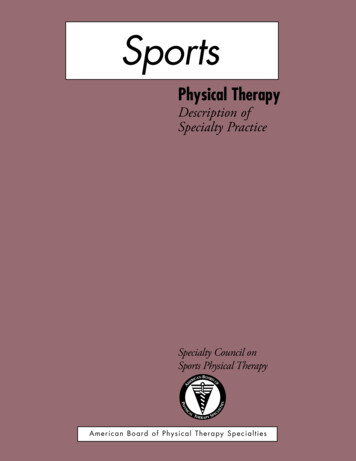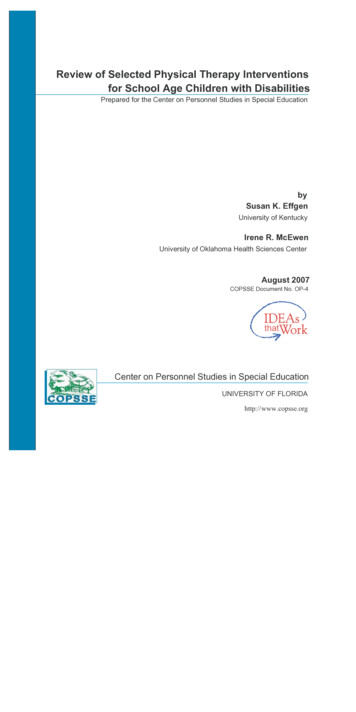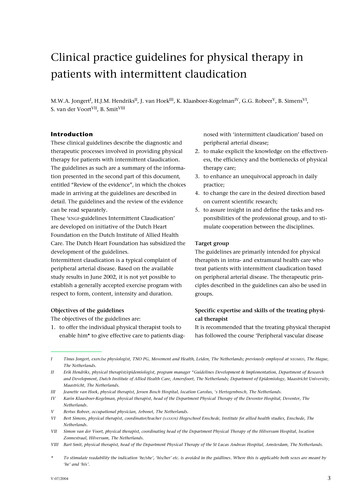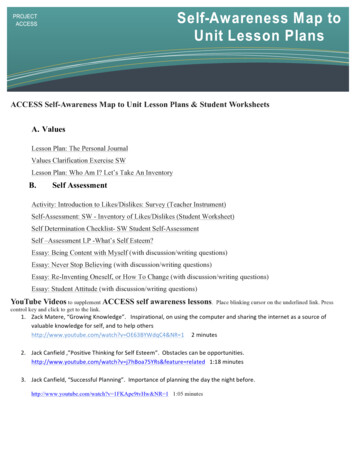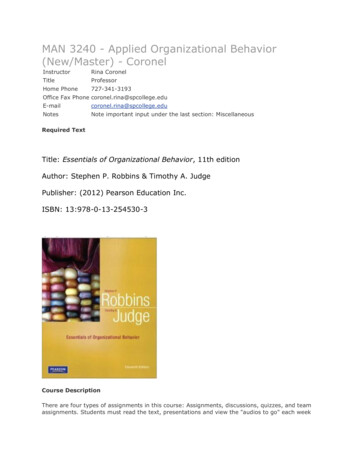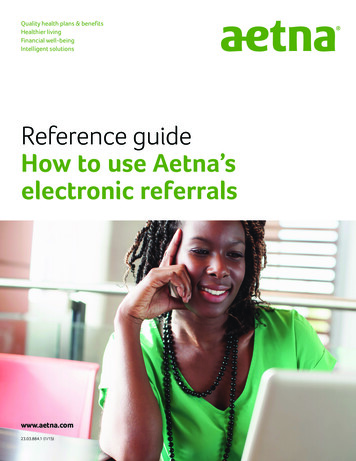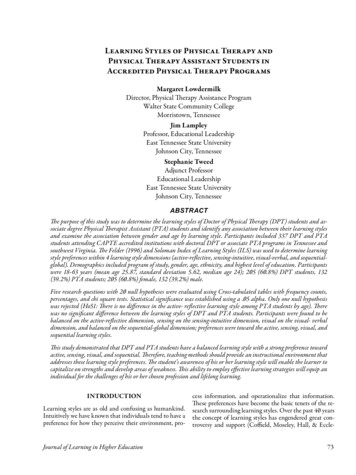
Transcription
Learning Styles of Physical Therapy andPhysical Therapy Assistant Students inAccredited Physical Therapy ProgramsMargaret LowdermilkDirector, Physical Therapy Assistance ProgramWalter State Community CollegeMorristown, TennesseeJim LampleyProfessor, Educational LeadershipEast Tennessee State UniversityJohnson City, TennesseeStephanie TweedAdjunct ProfessorEducational LeadershipEast Tennessee State UniversityJohnson City, TennesseeABSTRACTThe purpose of this study was to determine the learning styles of Doctor of Physical Therapy (DPT) students and associate degree Physical Therapist Assistant (PTA) students and identify any association between their learning stylesand examine the association between gender and age by learning style. Participants included 337 DPT and PTAstudents attending CAPTE accredited institutions with doctoral DPT or associate PTA programs in Tennessee andsouthwest Virginia. The Felder (1996) and Soloman Index of Learning Styles (ILS) was used to determine learningstyle preferences within 4 learning style dimensions (active-reflective, sensing-intuitive, visual-verbal, and sequentialglobal). Demographics included program of study, gender, age, ethnicity, and highest level of education. Participantswere 18-63 years (mean age 25.87, standard deviation 5.62, median age 24); 205 (60.8%) DPT students, 132(39.2%) PTA students; 205 (60.8%) female, 132 (39.2%) male.Five research questions with 20 null hypotheses were evaluated using Cross-tabulated tables with frequency counts,percentages, and chi square tests. Statistical significance was established using a .05 alpha. Only one null hypothesiswas rejected (Ho51: There is no difference in the active- reflective learning style among PTA students by age). Therewas no significant difference between the learning styles of DPT and PTA students. Participants were found to bebalanced on the active-reflective dimension, sensing on the sensing-intuitive dimension, visual on the visual- verbaldimension, and balanced on the sequential-global dimension; preferences were toward the active, sensing, visual, andsequential learning styles.This study demonstrated that DPT and PTA students have a balanced learning style with a strong preference towardactive, sensing, visual, and sequential. Therefore, teaching methods should provide an instructional environment thataddresses these learning style preferences. The student’s awareness of his or her learning style will enable the learner tocapitalize on strengths and develop areas of weakness. This ability to employ effective learning strategies will equip anindividual for the challenges of his or her chosen profession and lifelong learning.INTRODUCTIONLearning styles are as old and confusing as humankind.Intuitively we have known that individuals tend to have apreference for how they perceive their environment, proJournal of Learning in Higher Educationcess information, and operationalize that information.These preferences have become the basic tenets of the research surrounding learning styles. Over the past 40 yearsthe concept of learning styles has engendered great controversy and support (Coffield, Moseley, Hall, & Eccle73
Margaret Lowdermilk, Jim Lampley, & Stephanie Tweedstone, 2004). Like many cognitive processes, the ability tounderstand or have an awareness of how one learns holdsgreat promise for the individual and the educator. “Recognizing and defining the styles by which a person learns isas important to the learning process as diagnostic tests areto the healing process in the field of medicine” (Friedman& Alley, 1984, p. 77).Doctor of physical therapy (DPTs) students and physicaltherapy assistants (PTAs) are important members of thehealthcare team. An investigation of the learning styles ofthese team members is critical to prepare physical therapystudents to meet academic and clinical challenges. Gaining an understanding of one’s preference for receivingand processing information will benefit the student, thehealthcare team, and ultimately the patient. Assessmentof learning style preferences enables students to organizeand process information to their advantage. Also, knowledge of the various learning styles within a class helps instructors apply various pedagogical techniques. Educatorsare able to provide effective learning experiences based onpreferred learning styles and strengthen non-preferredlearning styles only when the students’ learning styleshave been identified (French, Cosgriff, & Brown, 2007).Over the past 40 years learning styles have been studiedin an attempt to help educators be more responsive todiverse student needs, communicate information in amore efficient way, and determine if students with specificlearning style preferences are attracted to certain professions (Hauer, Straub, & Wolf, 2005). Felder and Brent(2005) agreed that if instructors understand the learningstyle differences in their class they have a better chance ofmeeting the needs of those diverse learners. However, it isimpractical to even consider tailoring completely individualized instruction for each student in the class and just asimpractical is the idea that if an instructor were to adoptonly one approach to teaching that the needs of every student would be met (Felder & Brent, 2005). In the healthcare field a balance is needed to provide effective learningexperiences based on preferred learning styles and theneed to strengthen non-preferred learning styles (Frenchet al., 2007). The literature is replete with learning styledata about baccalaureate and masters prepared nursingand various allied health professionals. However, there isa dearth of information related to the learning styles ofcommunity college allied health students. This study willprovide valuable information related to the DPT studentand the PTA student.This study will also contribute data to the already existingbody of knowledge on the learning styles of allied healthstudents. Specifically, this study will expand the body ofknowledge by identifying the learning style preferences ofPTA students. The results gleaned will help equip both74educator and student with the tools to embark on a lifelong journey of learning and the integration of knowledgeinto clinical practice.As the field of physical therapy becomes more complex,the need for lifelong learning has become a fundamental skill and a necessary component in staying abreast ofbest practices. The PTA’s role requires the developmentof inductive and deductive reasoning processes to provideoptimum care for the patient and to support the DPT.Not only is there a paucity of information regarding thelearning styles of DPTs and PTAs, research regardingtheir learning styles remains relatively untouched. Thepurpose of this study is to provide information about thelearning styles of DPTs and PTAs. Learning styles are animportant component of learning, imperative for effectiveteam relationships within a challenging healthcare environment, and a critical component to become an effectivelife-long learner.LITERATURE REVIEWLearning style research is diverse, extensive, and hastouched virtually every healthcare program of study. Thevalue of learning styles to students, educators, practitioners, and patients cannot be overstated, especially in anage where technological advances push the boundariesof our imagination. Skills for lifelong learning, interpersonal skills, and communication skills are paramount forhealthcare workers today.The provision of healthcare has changed over the pastdecades with interdisciplinary teams providing highlyspecialized care concurrently. “If communication andhence performance, of teams is influenced by how teammembers view and interpret clinical information do otherdifferences in information-processing styles impact teamperformance” (Sandmire et al., 2000, p. 143)? Various assessment tools to identify learning styles have been developed. However, the Kolb’s Learning Style Inventory (LSI)has become the most frequently used method for assessing learning style in health science literature (French et al.,2007; Hauer et al., 2005; Katz & Heimann, 1991; Sandmire et al., 2000; Wessel et al., 1999).Research has been conducted to identify the learningstyles of allied health students using various forms of theKolb Learning Style Inventory. One such study found occupational therapist students were assimilators, nursingstudents were divergers, and physical therapist studentswere identified as convergers (Hauer et al., 2005). Frenchet al. (2007) found that the two most prevalent learningstyles for occupational therapist students were convergerand diverger. In contrast, Katz and Heimann (1991)Fall 2017 (Volume 13 Issue 2)
Learning Styles of Physical Therapy and Physical Therapy Assistant Students in Accredited Physical Therapy Programsfound that occupational therapy students and practitioners were accommodators.Learning styles of allied health students were initiallystudied in the 1970s. Rezler and French (1975) developedtheir own Learning Preferences Inventory (LPI) and included six dimensions (abstract, concrete, individual, interpersonal, student-structured, and teacher-structured).Physical therapy students were high on teacher-structured, concrete, and interpersonal learning. Barris, Kielhofner, and Bauer (1985) found that both occupationaltherapist and physical therapist students preferred teacher-structured, concrete, and interpersonal learning. Inaddition physical therapy students showed less preferencefor teacher-structured learning compared the occupational therapy students. This study also found that physicaltherapy students valued wisdom, preferred abstract learning, and were satisfied with their education.Peyton, Hueter, and McDonald (1979) studied learningstyle preferences of physical therapy students in the United States and found physical therapy and nursing studentsneeded more organization and direct experience than allother groups studied. A study to identify the learningstyles of Australian physiotherapy students found that themost frequently preferred learning style was assimilators(reflector) (Mountford, Jones, & Tucker, 2006). Anotherstudy found that a majority of Canadian physiotherapystudents exhibited assimilative or convergent learningstyles. Student in both groups (assimilative and convergent) used abstract conceptualization as a predominantlearning preference. The assimilators coupled this with reflective observation, whereas the convergers coupled thiswith active experimentation. Therefore, physical therapystudents seem to learn by thinking and place less emphasison personal involvement with people (Wessel et al., 1999).Careful attention to the learning style literature demonstrates that there are a variety of opinions and definiteflaws in the research, but no one refutes the idea that individuals have preferred ways of taking in and processinginformation. “We each are born with predisposition forlearning in certain ways. We also are products of external influences, especially within our immediate family,extended community, and culture” (Guild, 2001, The Nature vs. Nurture Issue, para. 1).[A] key to educational and professional success isthe ability to adapt to different situations – including adapting one’s learning style. Style flexibility is required for choosing or developing an appropriate strategy for and employing appropriatetactics in a novel situation. (Curry, 1999, p. 411)develop the ability to adopt different learning styles in different situations, recognize their own learning strengthsand preferences, and approach learning situations withflexibility” (Loo, 2002, p. 256). Will learning styles remain relevant within educational theory and pedagogicconcepts? Despite the controversy and debate concerninglearning styles and the validity of learning style measurement instruments,[E]fforts to better define and utilize learning styletheory is an area of growing research. A betterknowledge and understanding of learning stylesmay become increasingly critical as classroom sizes increase and as technological advances continueto mold the types of students entering higher education. (Romanelli, Bird, & Ryan, 2009, p. 4)With debate and controversy surrounding decades of psychological and educational research on learning styles, theadvances in neuroscience and Functional Magnetic Resonance Imaging (fMRI) may provide empirical evidencefor individual differences associated with preferences andlend support for evidenced-based instructional and teaching practices.RESEARCH METHODOLOGYThe purpose of this study was to determine the learningstyles of doctor of physical therapy (DPT) students andphysical therapist assistant (PTA) students and identifyany association between their learning styles. In addition, this study examined the learning style dimensionsfrequently associated with DPT and PTA students. Thisstudy also examined the association between demographiccharacteristics and learning styles. This chapter describesthe research design, study population, data collection procedures, data collection instrument, psychometrics of theinstrument, the research questions, and null hypotheses.A nonexperimental study design using a conveniencesample was used to examine learning styles of studentsenrolled in the first, second, and third year of DPT education programs and during the first and second year ofPTA education programs at selected Commission onAccreditation in Physical Therapy Education (CAPTE)(2016a) accredited universities and community collegesin Tennessee and southwest Virginia. Learning style anddemographic data were gathered from each study participant. Approval from the East Tennessee State University(ETSU) Institutional Review Board was obtained beforethe start of the study.Flexibility in learning styles is echoed by Loo (2002),“There appear to be substantial benefits to students whoJournal of Learning in Higher Education75
Margaret Lowdermilk, Jim Lampley, & Stephanie TweedResearch QuestionsThe following research questions were developed as a focus for this study.RQ1: Is there a significant difference between doctorof physical therapy students and physical therapist assistant students in each of the four learning styles of the Felder-Soloman Learning StylesInventory: Active and Reflective learners, Sensingand Intuitive learners, Visual and Verbal learners,and Sequential and Global learners?Ho11: There is no difference in the Active and Reflective Learning Style (active, balanced,and reflective) between doctor of physicaltherapy students and physical therapist assistant students.Ho12: There is no difference in the Sensing andIntuitive Learning Style (sensing, balanced,and intuitive) between doctor of physicaltherapy students and physical therapist assistant students.Ho13: There is no difference in the Visual and Verbal Learning Style (visual, balanced, andverbal) between doctor of physical therapystudents and physical therapist assistantstudents.Ho14: There is no difference in the Sequential andGlobal Learning Style (sequential, balanced, and global) between doctor of physical therapy students and physical therapistassistant students.RQ2: Among doctor of physical therapy students isthere a significant difference between Male andfemale students in each of the four learning stylesof the Felder-Soloman Learning Styles Inventory:Active and Reflective learners, Sensing and Intuitive learners, Visual and Verbal learners, and Sequential and Global learners?Ho21: Among doctor of physical therapy studentsthere is no difference in the Active and Reflective Learning Style (active, balanced,and reflective) between male and femalestudents.Ho22: Among doctor of physical therapy studentsthere is no difference in the Sensing andIntuitive Learning Style (sensing, balanced, and intuitive) between male andfemale students.Ho23: Among doctor of physical therapy studentsthere is no difference in the Visual andVerbal Learning Style (visual, balanced,76and verbal) between male and female students.Ho24: Among doctor of physical therapy studentsthere is no difference in the Sequential andGlobal Learning Style (sequential, balanced, and global) between male and female students.RQ3: Among physical therapist assistant students isthere a significant difference between male andfemale students in each of the four learning stylesof the Felder-Soloman Learning Styles Inventory:Active and Reflective learners, Sensing and Intuitive learners, Visual and Verbal learners, and Sequential and Global learners?Ho31: Among physical therapist assistant studentsthere is no difference in the Active and Reflective Learning Style (active, balanced,and reflective) between male and femalestudents.Ho32: Among physical therapist assistant students there is no difference in the Sensingand Intuitive Learning Style (sensing, balanced, and intuitive) between male andfemale students.Ho33: Among physical therapist assistant studentsthere is no difference in the Visual and Verbal Learning Style (visual, balanced, andverbal) between male and female students.Ho34: Among physical therapist assistant students there is no difference in the Sequential and Global Learning Style (sequential,balanced, and global) between male andfemale students.RQ4: Among doctor of physical therapy students isthere a significant difference among age groupsin each of the four learning styles of the FelderSoloman Learning Styles nventory: Active andReflective learners, Sensing and Intuitive learners,Visual and Verbal learners, and Sequential andGlobal learners?Ho41: Among doctor of physical therapy studentsthere is no difference in the Active and Reflective Learning Style (active, balanced,and reflective) based on age.Ho42: Among doctor of physical therapy studentsthere is no difference in the Sensing andIntuitive Learning Style (sensing, balanced, and intuitive) based on age.Ho43: Among doctor of physical therapy studentsthere is no difference in the Visual andVerbal Learning Style (visual, balanced,and verbal) based on age.Fall 2017 (Volume 13 Issue 2)
Learning Styles of Physical Therapy and Physical Therapy Assistant Students in Accredited Physical Therapy ProgramsHo44: Among doctor of physical therapy students there is no difference in the Sequential and Global Learning Style (sequential,balanced, and global) based on age.RQ5: Among physical therapist assistant students isthere a significant difference among age groupsin each of the four learning styles of the FelderSoloman Learning Styles Inventory: Active andReflective learners, Sensing and Intuitive learners,Visual and Verbal learners, and Sequential andGlobal learners?Ho51: Among physical therapist assistant students there is no difference in the Activeand Reflective Learning Style (active, balanced, and reflective) based on age.Ho52: Among physical therapist assistant students there is no difference in the Sensingand Intuitive Learning Style (sensing, balanced, and intuitive) based on age.Ho53: Among physical therapist assistant students there is no difference in the Visualand Verbal Learning Style (visual, balanced, and verbal) based on age.Ho54: Among physical therapist assistant students there is no difference in the Sequential and Global Learning Style (sequential,balanced, and global) based on age.SampleThe participants in this study included DPT and PTAstudents attending CAPTE accredited universities or colleges that offer a DPT program or PTA associate programin Tennessee and southwest Virginia.Participants in this study represented DPT students fromtwo universities and PTA students from four communitycolleges who agreed to participate in this study. The participants were enrolled during the fall semester of 2015at one of the participating institutions. DPT studentsattending one of the two universities were in their first,second, or third year of a doctoral degree program. PTAstudents attending one of the four community collegeswere in their first or second year of an associate degreeprogram.The Commission on Accreditation in Physical TherapyEducation (CAPTE) is the only accreditation agency recognized by the United States Department of Education(USDOE) and the Council for Higher Education Accreditation (CHEA) to certify entry-level DPT and PTAeducation programs (CAPTE, 2016b). Accreditation is avaluable service to the public, students, educational institutions, the programs, and the profession to assure thatJournal of Learning in Higher Educationgraduates from an accredited program meet standardsset by the profession. CAPTE accredits first professional(entry-level) programs in the US for DPTs at the masterand doctoral levels and for PTAs at the associate level.CAPTE assures quality and continuous improvement byestablishing and applying standards in the preparation ofDPTs and PTAs. Accreditation assures that standards reflect the evolving nature of education, research, and practice and are adhered to by universities and colleges offering entry-level preparation of DPTs and PTAs (CAPTE,2015).There were 337 student participants in this study. Demographic data collected included program of study, gender,age, ethnicity, and highest level of education obtained inany area prior to the current program of study. Participants’ ages ranged from 18 to 63 years with a mean ageof 25.87 and standard deviation of 5.62; the median agewas 24. Of the 337 participants 205 (60.8%) were doctor of physical therapy (DPT) students and 132 (39.2%)were physical therapist assistant (PTA) students. Therewere 205 (60.8%) female and 132 (39.2%) male participants. Among female participants 121 (59.0%) were DPTstudents; among male participants 84 (63.6%) were DPTstudents. The majority of participants held a baccalaureate degree as the highest level of education prior to beginning the current program of study. There were 91 (27.0%)participants holding an associate degree or lower, 237(70.3%) participants at the Baccalaureate level, and nine(2.7%) holding a masters or higher degree.InstrumentationThe Felder and Soloman Index of Learning Styles (ILS)instrument developed in 1991 was used in this study toascertain the learning styles of DPT and PTA students.The ILS instrument was adapted from the Felder and Silverman model developed in 1987.Considering the plethora of learning style models and instruments to assess learning styles the Felder and Silverman model was chosen for this study because the modeldimensions were formulated from studies particularly relevant to science education (Felder, 1993). The Felder andSilverman model was designed to be particularly applicable to assess learning style differences among engineeringstudents and identify learning preferences based on fourdimensions (Felder & Spurlin, 2005): sensing (concrete, practical, oriented toward factsand procedures) or intuitive (abstract thinker, innovative, oriented toward theories and underlying meanings);77
Margaret Lowdermilk, Jim Lampley, & Stephanie Tweed visual (prefer visual representations of presentedmaterial, such as pictures, diagrams and flowcharts) or verbal (prefer written and spoken explanations); active (learn by trying things out, enjoy workingin groups) or reflective (learn by thinking thingsthrough, prefer working alone or with a singlefamiliar partner); sequential (linear thin king process, learn in smallincremental steps) or global (holistic thinking process, learn in large leaps). (Felder & Spurlin, 2005,p. 103)Felder and Soloman developed the 44-item forced-choiceILS instrument to assess preferences on the four scales ofthe Felder and Silverman model (Felder & Brent, 2005). Apencil-and-paper version of the instrument was put on theInternet in 1996 and an online version was made availablein 1997. Permission was obtained from Dr. Richard Felderto use the Felder-Soloman ILS instrument (Appendix A)and the Index of Learning Styles Report Form (Appendix B). The ILS is available at no cost to individuals whowish to assess their own preferences and to instructorsand students who wish to use it for classroom instruction or research (Felder & Spurlin, 2005). The ILS learning styles dimensions are dichotomous, consisting of 11forced-choice items for each domain with scores rangingfrom -11 to 11 in increments of 2 (-11, -9, -7, 7, 9, 11).The dimensions represent continua rather than either/orcategories and scoring indicates that one’s preferences maybe strong, moderate, or almost nonexistentData CollectionPermission to conduct this study was obtained from theEast Tennessee State Institutional Review Board. AfterIRB approval was granted from ETSU and each participating institution, the directors of the DPT and PTAprograms at each of the participating institutions werecontacted to determine a convenient time to conduct theILS survey with students. Study participants were askedto complete the Index of Learning Styles Questionnaire(Appendix A), Student Demographic Information Form(Appendix C), and the Participant Informed ConsentForm (Appendix D).After receiving IRB approval from each institution, eachprogram director was contacted for permission to visitand talk with students about the study and scheduled adate and time for the visit. The researcher met with thestudents at each institution to inform them of the study,answer questions, and distribute the packets. Participantpackets consisted of the Index of Learning Styles Questionnaire, Student Demographic Information Form, and78Participant Informed Consent Form; each participantwas asked to complete all packet materials. To assureanonymity no identifying information was requested orrecorded. After a mutually agreed upon time was established, the researcher traveled to each institution to distribute and collect the ILS and other materials containedin the participant packet.Data AnalysisDescriptive statistics and inferential statistics were calculated and reported in this study.Specifically, cross-tabulated tables with frequency countsand percentages and a series of chi square tests were usedto address the research questions. Statistical significancewas established using an alpha level of .05. Data were analyzed using the Statistical Package for the Social Sciences(SPSS).Research FindingsOf the 20 null hypotheses evaluated, only one was rejected (Ho51: Among physical therapist assistant students,there is no difference in the Active and Reflective Learning Style (active, balanced, and reflective) based on age).Among PTA students, 41.9% of those age 24 and youngerreported an active learning style compared to 21.7% ofPTA students age 25 and older. There were no other findings that were of statistical or practical significance.Although not subjected to statistical testing, univariatedescriptive statistics for each of the four learning style dimensions provided insight into the learning styles of students in physical therapy programs regardless of the typeof program, gender, or age of students in each program:1. On the active-reflective dimension the majority of students (56.3%) were balanced. Whencombined with students who scored active onthe continuum, 84.3% scored either active orbalanced on this continuum. Almost 16% scoredreflective on the continuum.2. On the sensing-intuitive dimension the majorityof students (62.8%) were sensing. When combined with students who were balanced, 95.5%were either sensing or balanced; a small percentage (4.5%) of students were intuitive.3. On the visual-verbal dimension the majority ofstudents (55.4%) were visual. Almost 96% wereeither visual or balanced on this learning stylecontinuum; a small percentage (4.5%) of students were verbal.Fall 2017 (Volume 13 Issue 2)
Learning Styles of Physical Therapy and Physical Therapy Assistant Students in Accredited Physical Therapy Programs4. On the sequential-global dimension the majority of students (58.6%) were balanced. Whencombined with students who were sequential,93.4% were either sequential or balanced; a smallpercentage (6.6%) of students were global.There was no difference in the learning styles of the DPTstudents and the PTA students. Of interest, although notstatistically significant, was the highest percent differencebetween the DPT students and the PTA students werethe sensing-intuitive and visual-verbal dimensions.Results of the study revealed that 69% of the PTA students were sensing [practical, oriented toward facts anddetails, and concrete thinker (Felder & Silverman, 1988)]and 58.7% of the DPT students were sensing. In contrast 45.3% of all students were intuitive [innovative, creative, prefer principles and theories, and abstract thinker(Felder & Silverman, 1988)]. The next highest percent difference between DPT students and PTA students was thevisual-verbal dimension; 59% of the DPT students werevisual [prefer pictures, diagrams, flow charts, films, anddemonstrations (Felder & Silverman, 1988)] and 49.6% ofthe PTA students were visual. In contrast 45.2% of all students were verbal [prefer written and spoken explanations(Felder & Spurlin, 2005)].A statistically significant difference was found in theactive-reflective learning style dimension among PTAstudents based on age. Among PTA students 41.9% ofstudents age 24 and younger reported an active learning style compared to 21.7% of PTA students age 25 andolder. However, among PTA students age 24 and younger53.2% were balanced and for PTA students age 25 andolder 63.8% were balanced on the active-reflective learning style dimension. There was a high percentage (74.1%)of PTA students age 24 and younger and 69.1% age 25 andolder who were sensing on the sensing-intuitive learningstyle dimension. A slightly higher percentage of PTA students (52.6%) age 24 and younger and 52.4% age 25 andolder were visual on the visual-verbal learning style dimension. The sequential-global learning style dimensionwas balanced among PTA students based on age.A statistically significant difference was not found amongDPT students across any learning style dimension b
Learnin Styles of Physical Therapy and Physical Therapy Assistant Students in Accredited Physical Therapy Programs Journal of Learning in Higher Education 75 found that occupational therapy students and practitio-ners were accommodators. Learning styles of allied health students were initially studied in the 1970s. Rezler and French (1975 .

